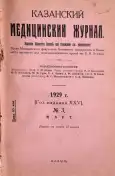О влиянии антисифилитического лечения на течение менструаций у сифилитичек
- Авторы: Батунин М.П.1
-
Учреждения:
- Казанская кожно-венерологическая больница Т. Н. К
- Выпуск: Том 25, № 3 (1929)
- Страницы: 319-321
- Тип: Статьи
- URL: https://bakhtiniada.ru/kazanmedj/article/view/79060
- DOI: https://doi.org/10.17816/kazmj79060
- ID: 79060
Цитировать
Полный текст
Аннотация
Считается установленным, что месячные, приходящие в срок регулярно, служат показателем нормального состояния женской половой сферы и, наоборот, нарушение правильности менструаций указывает на функциональное расстройство полового аппарата. Физиология и патология менструального типа настолько ужо изучены, что по определенным изменениям мы можем судить о состоянии органов, участвующих в менструальном цикле—а именно яичника и матки. Новейшие исследования над действием различных белковых субстанций, а также некоторых препаратов (например, иод) показали, что орган регулирующий менструацию- яичник—оказывается довольно чувствительным к введению этих веществ. С этой точки зрения не следовало бы оставлять без внимания возможного влияния наличник со стороны таких сильно действующих, частью токсичных препаратов, какие употребляются при лечении сифилиса. В качестве клинического критерия о состоянии яичника при лечении сифилиса могло бы служить наблюдение за правильностью менструальной функции пациентки. Вопрос о влиянии специфического лечения на течение у женщины менструаций в медицинской литературе разработан еще чрезвычайно мало. Так Lecaperé (в «Traitement de la syphilis») указывает на то, что регулы у некоторых больных при лечении Ві становились чаще и обильнее. Levaditi пишет, что метроррагии и эрозивные баляниты, сопровождающиеся пигментацией препуция, цитируются среди наиболее редких побочных явлений при висмутовой терапии. Такие же указания имеются у Н. Förtigа, Rudolfloffe (Handbuch der Salvarsantherapie—Коlle и Zieler). По Мульцеру начавшиеся регулы не составляют противопоказания для продолжения лечения. Наиболее подробно вопрос освещен и проверен клинически у Кана п Смелова, которые указывают, что практически врачу при специфическом лечении у женщин приходится решать такие вопросы: 1) нужно ли прекращать лечение во время регул, 2) как влияют специфические лечебные мероприятия (втирание ртути, инъекции, вливания) на тип месячных у сифилитичек, половые органы которых нормальны и 3) как влияет лечение на сифилитичек, у которых уже было расстройство менструаций до начала специфического лечения. В отношении первого вопроса—терапии во время менструаций Кан и Смелов считают, что у лиц, здоровых в половом отношении и страдающих инфекционными и не инфекционными заболеваниями не гинекологического характера, лечение в большинстве случаев не изменяет менструального типа и может продолжаться во время регул без перерыва. По второму вопросу о влиянии лечения на тип месячных констатируется следующее: «Рациональная терапия (медикаментозная, физиотерапевтическая, климатическая, бальнеологическая) имеет положительное влияние в смысле улучшения менструального типа у конституционально-малоценных субъектов.
Ключевые слова
Полный текст
Открыть статью на сайте журналаОб авторах
М. П. Батунин
Казанская кожно-венерологическая больница Т. Н. К
Автор, ответственный за переписку.
Email: info@eco-vector.com
старший врач больницы
Россия, КазаньСписок литературы
Дополнительные файлы





